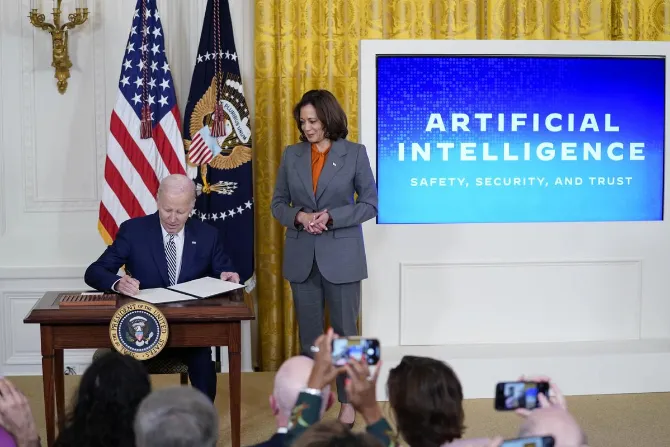-
CENTRES
Progammes & Centres
Location
By signing the executive order on AI, the Biden administration may have taken the first step in strategically positioning the US in the evolving landscape of AI control and governance

On 30 October 2023, President Joe Biden of the United States (US) signed a crucial Executive Order (EO) focusing on the “safe, secure, and trustworthy development and use of Artificial Intelligence” (AI). The presidential decree, ahead of the AI safety summit in the United Kingdom (UK) held on 1-2 November, underscored preemptive steps that the US may be taking in ensuring a pioneering role in harnessing the potential of AI, while still effectively managing associated risks. The EO adopts a comprehensive approach, in its attempt to address critical dimensions, including national security, consumer protection, labour markets, privacy, and upholding equity, and civil rights. The order signals a commitment to establishing new standards, fostering innovation, safeguarding privacy, and maintaining American leadership in the global AI landscape. Despite pressing issues like the Maine shooting, the Israel-Hamas war, and the House speaker selection, Biden devoted an extended meeting which stretched to 70 minutes in the Oval Office to review and finalise the order, emphasising its significance in his administration's priorities.
AI has come to occupy both technological, political, and ethical significance, even as governance and development of AI have become intricate subjects for most governments. While the step to boost its AI ecosystem is an obvious pointer to Washington’s desire to maintain its tech superiority and leadership, the decision also entails a political imprint in its announcement exactly a year before the 2024 elections. With a strong emphasis on Responsible AI, the Biden administration may well be preparing to guard up against any possible misuse to impact democratic processes. Accompanied by a series of orders safeguarding semiconductor chip manufacturing technology from China, a fundamental necessity for advanced AI development, this move signals a pivotal step by the US to assert dominance in the AI field.
The launch of ChatGPT in November 2022 marked a ground-breaking step in AI revolution. Its democratised and unrestrained pattern of usage in the past year alone has raised issues on regulations and standards. It has also underscored that balancing adaptability, lethality and the usefulness of AI will require a global standard which may be difficult to achieve in the wake of emerging fractures in the world order and an ensuing tech race between the two leading powers of the world.
The EO initiates a directive that compels developers of powerful AI systems to share safety test results and crucial information with the US government. Under the Defense Production Act of 1950, companies developing foundation models which could pose national security risks must notify the federal government during model training and share red-team safety test results. The National Institute of Standards and Technology will institute stringent standards for red-team testing to ensure safety pre-public release to develop standards, tools, and tests to guarantee the safety, security, and trustworthiness of AI systems. In an effort to address the potential risks of AI in engineering dangerous biological materials, the order focuses on developing standards for biological synthesis screening. Additionally, it aims to protect against AI-enabled fraud and deception by establishing standards and best practices for detecting and authenticating AI-generated content. The establishment of an advanced cybersecurity program is proposed to identify and rectify vulnerabilities in critical software, building upon the ongoing AI Cyber Challenge.
The order mandates the development of a National Security Memorandum, directing further actions on AI and security, ensuring the safe, ethical, and effective use of AI by the US military and intelligence community. Countering the adversary’s military use through AI is an important component of this legislation. Under the theme of advancing equity and civil rights, the order recognizes the potential for irresponsible AI use to deepen discrimination and bias in various sectors, prompting actions to combat algorithmic discrimination. It highlights the changing landscape of jobs and workplaces due to AI, emphasising the need for supporting workers' collective bargaining and investing in accessible workforce training and development.
President Biden's signing of the CHIPS and Science Act on 9 August 2022, marked a pivotal moment in securing the future of semiconductor research and manufacturing in the US and globally. With an appropriation of US$52 billion, the act also earmarked around $200 billion for broader investments in scientific research, technology, education, and training. The subsequent AI EO signed by President Biden serves as a complementary directive, fortifying the CHIPS Act by aligning regulatory measures with its legislative provisions. Section 2 of the latest EO is dedicated to improving the regulatory mechanisms of the American government, employing direct and indirect control towards both AI-related investments as well as its innovation. Together, the 2022 legislative Act and executive action this year form a comprehensive strategy to secure America's prominence in semiconductor technology and AI innovation.
Biden’s EO, like all EOs, is meant to set the stage for new AI-related laws and regulations in the US. Given the interconnectedness of the semiconductor and tech sectors, AI-related regulations in the US are bound to have global repercussions, especially in its contribution to the US-China competition. While Biden’s legislative gamble attempts to regulate how the federal government uses artificial intelligence, how and to what extent the private sector will be aligned with the new AI laws remains to be seen. Challenges to the EO’s full-scale implementation remain, especially in the rapid hiring of AI experts with competitive salaries of the private sector. The reliance on executive authorities to regulate AI denotes a hurdle, since the US Congress has been unable to legislate on potential harm resulting from the adoption of advanced digital technologies. Importantly, the EO recognises the significant role of immigrants, international students and high-skilled temporary visa holders in the AI domain. The National Foundation for American Policy notes in this regard that, “immigrants have founded or cofounded nearly two-thirds of the top AI companies in the United States, and 70% of full-time graduate students in fields related to artificial intelligence are international students.” Biden will have to balance these expectations against his steps like adopting tighter immigration policies, as the two seem to work at cross-purposes. Indeed, there are hard lessons to be learnt about the US’s inability to regulate social media effectively and US lawmakers are keen to avoid a similar scenario as AI’s casts is shadow on most aspects of everyday life.
President Biden's EO on AI has garnered praise from civil society and tech industry groups for its foundational principles being rooted in the White House's blueprint for an AI bill of rights. There is a consensus in the Beltway that legislative backing may be imperative to codify these protections around AI. Andrew Ng, an AI leader and co-founder of Google Brain and Coursera, expresses concern that government oversight over AI may stifle innovation. Jon Schweppe, Policy Director of American Principles Project, acknowledges the order's valid concerns but argues for more private oversight of AI, suggesting that AI developers should face significant liability. There is a mix of views in the US which reflects a nuanced perspective, recognising the need for transparency and scrutiny in AI development. Despite differing viewpoints, there is a collective acknowledgment of the challenges and risks associated with AI, emphasising the importance of a balanced approach that promotes innovation while safeguarding against potential harms.
The global race for AI development, control and regulation is underway simultaneously with 37 AI-related laws passing in 127 countries in 2022 alone. As more countries get involved, the competition is likely to be pivoted around the two main global powers, the US and China with key countries like Canada, Japan, Germany, Taiwan, UK, Israel, India, Singapore playing significant role in shaping the AI ecosystem. With the EO, the Biden administration may have taken the first step in strategically positioning the US in the evolving landscape of AI control and governance and has set the tone for navigating the uncertainties of an AI future.
Vivek Mishra is a Fellow with the Strategic Studies Programme at the Observer Research Foundation
Pankaj Fanase is a research intern at the Observer Research Foundation
The views expressed above belong to the author(s). ORF research and analyses now available on Telegram! Click here to access our curated content — blogs, longforms and interviews.

Vivek Mishra is Deputy Director – Strategic Studies Programme at the Observer Research Foundation. His work focuses on US foreign policy, domestic politics in the US, ...
Read More +
Pankaj Fanase is a Doctoral scholar, CIPOD, at Jawaharlal Nehru University ...
Read More +